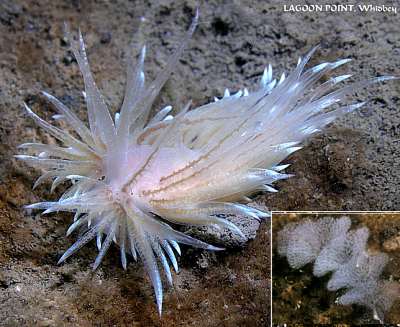
Cumanotus sp. 1
Order: NUDIBRANCHIA
Suborder: AEOLIDINA
Family: Cumanotidae
DISTRIBUTION
Pacific coast of Nth America from British Columbia, Canada to San Diego, California.
PHOTO
Whidbey Island, harbor, WAshington, USA. Pacific Ocean. Depth: 20 feet. Length: 1.25 inch. 21 December 2005. muddy. Photographer: Jan Kocian
An unnamed species listed as Cumanotus sp. 1 in Dave Behrens Pacific Coast Nudibranchs.
Although not studied anatomically the general shape of the body are charcteristic of the genus. One specific characteristic is the common base to the rhinophores. It has been reported to approximately 30 mm in length.
Authorship detailsRudman, W.B., 2006 (January 17) Cumanotus sp. 1 [In] Sea Slug Forum. Australian Museum, Sydney. Available from http://www.seaslugforum.net/find/cumasp1
Related messages
Cumanotus vs Cuthona divae
August 24, 2007
From: Kevin Lee
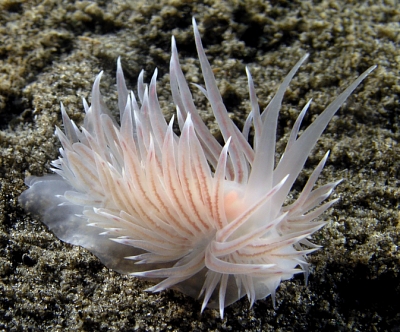
Hi Doc,
A few days ago, Terry Strait photographed Cumanotus sp., down in La Jolla Shores. On looking at his slug, it looked very similar to one I saw there last year, but thought it was Cuthona divae. Also, on reading Jeff Goddard's message #14582 and seeing Terry's entry #14560, I'm more convinced that my slug is indeed Cumanotus sp. Confirmation would be appreciated. I attach both animals for comparison.
Upper Photo: Cumanotus sp. La Jolla Shores, California; 65 fsw; Sandy bottom. Length: 4cm.09 Sep 2006. Middle: Cuthona divae. Redondo Canyon, California; 90f sw; 02 Aug 2007. Lower: Cuthona divae. Pt. Loma, San Diego, California; 75 fsw; 27 May 2007. Photographer: Kevin Lee.
Cheers,
K:-)
diverkevin@gmail.com
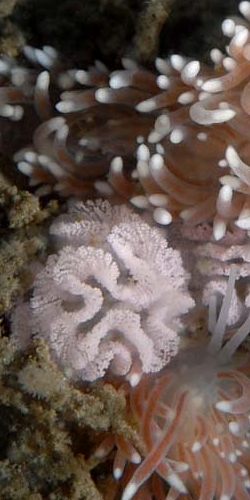
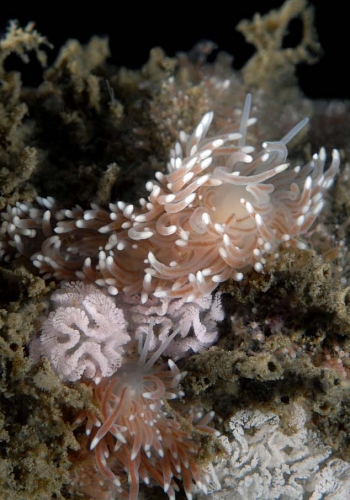
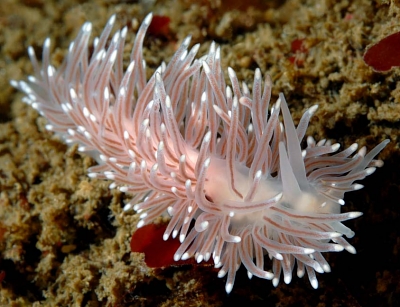
Hi Kevin,
You are absolutely correct with both ID's. Seems that our undescribed Cumanotus is having a population explosion in your area as I have received dozens of e-mails asking me if these are large Cuthona divae. Lets see if I can explain the obvious, external differences in these two aeolids.
To begin with the ceratal cores in this species of Cumanotus are spiraled and branched, while the cores in Cuthona divae are thin, smooth and straight tubes, as seen in your photo to the right. Secondly, the rhinophores of this Cumanotus are fused at the base (the photo on page 110, of Eastern Pacific Nudibranchs shows this well). Those in Cuthona are not. Lastly, the foot of this species of Cumanotus is quite wide, extending as wide as the spread of the lateral cerata. In Cuthona divae we can rarely see the foot as it does not extend laterally from the body.Several of the photos sent me in the last week show this species burrowing into the sediment, suggesting it might feed on worms or some other prey living buried. Most Cuthona prey on hydroids. We need more observations from you folks in Southern California to confirm this.
A note from Bill points out to me -- the egg mass in your photo is nearly identical to one submitted by Jackie Hildering [#20138, #20145 ]
Not sure this proves her eggs are Cuthona divae, but it supports my suggestion that she had more eggs from more than one species.Thanks for submitting these. Good stuff,
Dave Behrens
Cumanotus sp.1 from Washington (Nth Pacific)
January 18, 2006
From: Jan Kocian
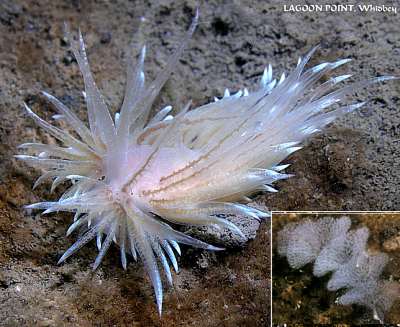
Hello Bill,
Diving the cold and dark waters here at Whidbey Island, I came across quite a few of this slug. I have not seen it here before. I guess it is Cumanotus sp.1 in Dave Behrens Pacific Coast Nudibranchs.
Locality: Whidbey Island, harbor, WAshington, USA. Pacific Ocean. Depth: 20 feet. Length: 1.25 inch. 21 December 2005. muddy. Photographer: Jan Kocian
Jan Kocian
honkoc@hotmail.com
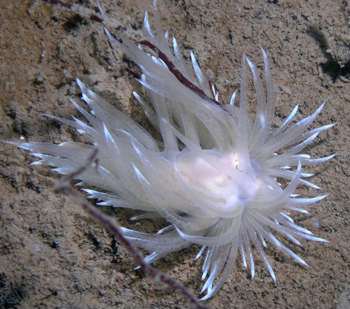
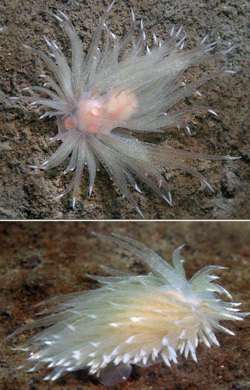
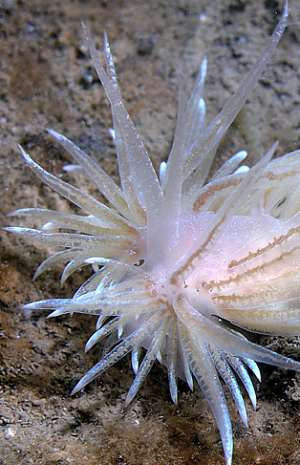
Dear Jan,
Another interesting addition. It certainly seems to be Dave's Cumanotus. It is interesting how the rhinophores have a common base, and also to see the shape of the egg ribbon.
Best wishes,
Bill Rudman
Cuthona divae from California
August 17, 2005
From: Terry Strait
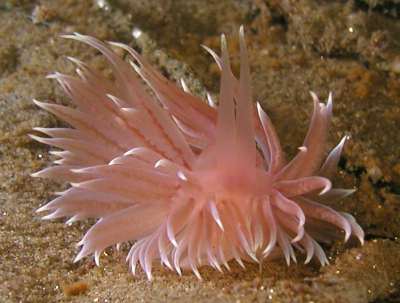
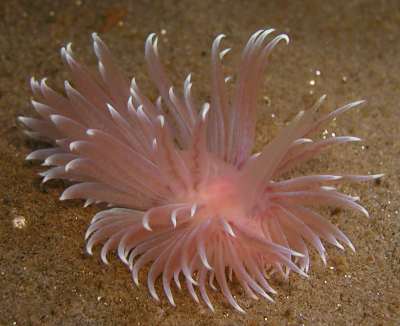
Hey Doc.
We have been seeing these lovely Cuthona divae off the coast of San Diego at La Jolla Shores. A friend has some nice shots of them feeding.
Photographed at La Jolla Shores, San Diego on a sandy bottom.
Locality: La Jolla Underwater Park, San Diego, California , USA. Depth: 48 ft. Length: 3 inches. 11 Aug 2005. soft sandy bottom. Photographer: Terry Strait
Terry Strait
divinman@sbcglobal.net
Strait, T.L., 2005 (Aug 17) Cuthona divae from California. [Message in] Sea Slug Forum. Australian Museum, Sydney. Available from http://www.seaslugforum.net/find/14560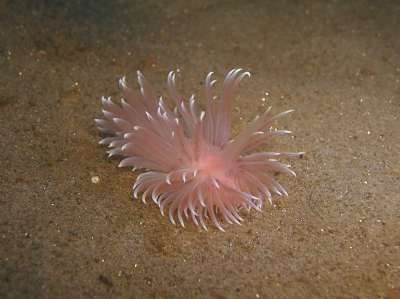
Note: This is Cumanotus sp. 1. See message #14582.
Dear Terry,
Thanks for the photos. I have included a copy of one of your wholephotos alongside as it shows how exposed the animal is in its environment. It certainly is not trying to hide. If your friend is willing to share his photos, I would love to have some of it feeding
Best wishes,
Bill Rudman
Re: Cuthona divae from California
August 17, 2005
From: Jeff Goddard
Hi Bill,
Concerning message #14560
I think the aeolid in Terry Strait's photo may be Cumanotus sp. (previously Flabellina sp. 1 of Behrens, 1991), not Cuthona divae. The body is much wider in Cumanotus, and I have never seen Cuthona divae with the tips of its cerata curled like that. Also, the cerata cores of the Cumanotus sp. pictured in Behrens (1991) ramify much more than in Cuthona, which also appears to be the case here. Finally, Cumanotus sp. inhabits soft sediments, while Cuthona divae usually seeks out hydroids on rock substrates. Behrens (2004) describes a unique, cerata-propelled swimming behavior in Cumanotus sp. which eventually may help pin down the identity of the Terry's specimen; otherwise, we need to examine the radula.
Best wishes,
Jeff:
goddard@lifesci.ucsb.edu
Goddard, J.H.R., 2005 (Aug 17) Re: Cuthona divae from California. [Message in] Sea Slug Forum. Australian Museum, Sydney. Available from http://www.seaslugforum.net/find/14582Thanks Jeff,
I wondered about its identity. That's why I asked for the feeding photos. Since Cuthona divae seems to feed on athecate hydroids such as Hydractinia, I thought perhaps this one's food choice could give some clues. Looking at the photo 156 in Dave's 1980 edition I can see a white streak running form the ceratal tip down one edge of each ceras. I had noticed a similar white streak on the cerata of Terry's animal so you may have the right answer. While looking at Dave's book I also noticed photo 159 'burrowing aeolid'. It looks very like that as well. Could it be the same thing?
Perhaps Terry can see if these animals swim or burrow next time he comes across them?
Best wishes,
Bill Rudman
